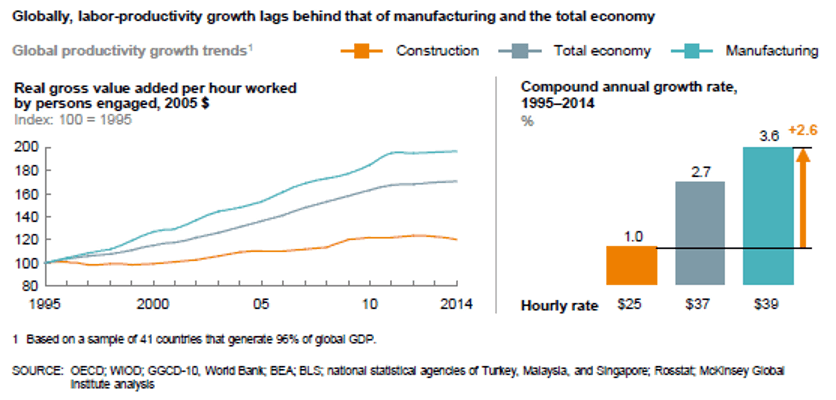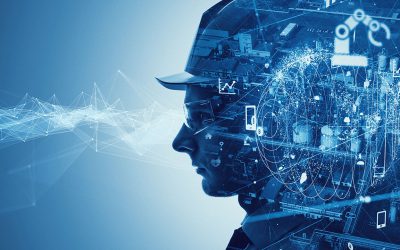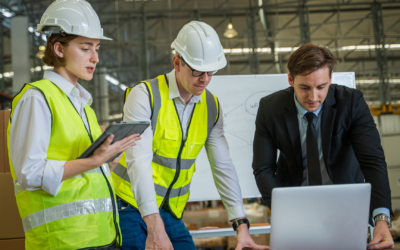How artificial intelligence improves productivity in the construction industry
Subscribe to our newsletter
Get the latest updates, trends and news directly in your inbox.
AI has the potential to drive countless business improvements across the construction sector – everything from designing better buildings to creating safer job sites. But AI’s most anticipated contribution lies in its ability to improve productivity.
Productivity is important because it is at the heart of reducing inefficiencies, delivering on-time projects, and managing costs. Productivity can be defined in many ways. However, it usually refers to labour productivity or the units of work produced per person-hour. When you consider that labour costs account for between 30% and 50% of the total cost of a construction project, you can appreciate the compelling argument for innovation and change.
In its report Reinventing Construction: A route to Higher Productivity, McKinsey & Company outlined that the construction sector has averaged 1% labour-productivity growth a year for the past 20 years. The trend has remained flat in most advanced economies and puts the industry well behind other sectors. In the case of the United States, construction work productivity has declined since 1968. In Singapore, construction productivity has grown at less than 0.3% annually between 1992 and 2018.
Compounded over the 1995 to 2014 period, global manufacturing productivity has nearly doubled. Construction, on the other hand, has increased by just 20%. If construction productivity could catch up with the worldwide economy, productivity would increase by almost 50%, using the same resources.

McKinsey & Company believes the construction sector can catch up. Roughly 30% improvement can be achieved by improving constructability through better design and engineering solutions. The balance rests in the hands of construction companies themselves.
The sector can find another 30% to 40% increase by using more innovative supply-chain management, on-site execution, technology, and capability-building techniques. All up, this equates to a cost saving of up to 25%. Selected pockets of the construction sector could even increase their productivity by a factor of 5 to 10 using off-site modular prefabrication solutions, for example.
The McKinsey & Company report also highlights that the construction sector needs to take a different perspective to boost productivity. Digital technologies have an important role to play in the transformation.
Technology and AI to the rescue
Taking a systems approach comprising technical, social, and managerial components is the best way to improve efficiency and productivity. The implementation of these systems involves policies, processes, practices, and tools. All changes need to meet the needs of the many different construction workers.
Digital collaboration platforms are pivotal business tools in many sectors outside of construction. Their popularity stems from the value they deliver. These tools help enhance ideas, reduce miscommunication, speed up information sharing, increase buy-in, and decrease rework and change orders.
The construction sector is starting to reap the benefits of using drones and other crewless aerial or ground vehicles. Equipped with sensing equipment such as optical cameras or 3D imaging lasers, these devices carry out surveying and monitoring activities and are particularly useful in unsafe or inaccessible areas. Moving forward, autonomous pieces of construction equipment will gradually make their way to job sites, including everything from hoisting and lifting machines to brick-laying robots. 3D wall printing is also expected to grow in popularity, particularly for off-site prefabricated modules.
Sensors are starting to proliferate job sites as the sector adopts Internet of Things (IoT). When used in conjunction with AI, this will enable asset and worker geolocation as well as continuous site monitoring. Data will be ubiquitous and advanced analytics will be used to understand data patterns. This will increase the overall efficiency and effectiveness by deploying real-time solutions, preventing breakdowns and downtime, and cutting waste and idle time.
Even workforce management will become easier with digital and AI solutions in the future. This is relevant to recruitment, attendance monitoring, task allocation, productivity and quality performance analysis, detection of training needs, and training effectiveness evaluation.
While there are many areas to explore, let’s take some time to delve into AI scheduling in some detail to understand more about the specific benefits and possibilities.
Scheduling right
The primary causes of poor productivity are often cited as ineffective planning and scheduling. Top-down master planning fails for two mutually reinforcing reasons:
- Individual tasks are subject to significant variance relative to their planned characteristics.
- Real-time information on variability is not fed back from the construction site into the master planning system.
Because of the lack of effective updates, issues ripple throughout the master schedule, and coordination issues are amplified along the way.
Many organisations respond to this by increasing the labour capacity or material inventory, which reduces productivity until the master schedule is unreliable. Digitalisation and AI can avoid this scenario. Instead, these tools can help to identify the root cause of each issue and provide many productivity gains along the way.

More accurate task duration predictions
A scheduling solution informed by AI technology learns to predict the duration of every single task based on hundreds of input variables. These inputs might come from digital site reports updated in real time (supply delivery, material consumption, and equipment usage) or mobile applications tracking tasks assigned to each worker. Predictions could consider:
- Weather conditions (extreme temperatures lower productivity)
- Individual worker characteristics (including skill level, performance track record, and recent overtime)
- Supervisor characteristics (leadership style, skill, and motivational ability)
The solution identifies meaningful lead time drivers and reduces the variance of the task lead time relative to the plan.
Higher reliability of the master schedule
Through the real-time collection of site data, an AI solution can immediately feed information back into the master schedule. Potential drifts are captured from the start and contained. Higher reliability at a task level allows for higher reliability at a project level.
This leads to more precise resource allocation and a reduction in idle or interruption time, strengthening dependability. Over time, this self-reinforcing system creates a virtuous cycle of favourable results.
Optimisation of the master schedule
As the process becomes better controlled at an individual task level, AI insights on lead time drivers, in conjunction with Lean methodology practices, enable a progressive reduction of task lead time. Once individual tasks are under control and optimised, the scheduling AI can start working on optimising the master schedule itself.
Agreeing on the shortest schedule is always a challenge when assessing capacity, resources, and sequencing constraints. However, an AI system will explore millions of performance indicator combinations to optimise the lowest total cycle time or cost. Organisations can run simulations to evaluate different scenarios, like workforce sizes, and select the most suitable option.
It is important to point out that powerful schedule optimisation algorithms already exist today. The paradigm shift being discussed here will only be driven by higher reliability at a task level. The prerequisite is to capture enough valuable data. This is already achievable by deploying mobile applications, localisation technology, and IoT, among other strategies.
The scheduling AI will not compress schedules by shortening incompressible individual tasks. But it will find the best sequence under constraints for these tasks, which human experience and expertise may overlook. The schedule and its performance should remain relatively unaffected by small input variations.
To provide reliable data, the scheduling AI needs to run regularly, possibly daily, or at shorter intervals. This helps to account for changes to the site environment (unexpected weather), project-related events (supply chain issues), or construction-related developments (change orders).
Experts might argue that scheduling is a complex art well beyond the capability of machines. People will indeed be required to evaluate scheduling constraints and incompatibilities at the beginning of the process. But the odds suggest that with continued human support and oversight, AI algorithms will quickly surpass our ‘human’ abilities to make highly effective decisions as quickly.
This article is based on the Novade AI whitepaper “How AI will Revolutionise Construction Site Management”.

Denis is the founder and CEO of Novade and believes in a hands-on approach to building projects. A business leader with a track record in building global teams, Denis grew up in France, obtained his Master of Science degree at MIT, and previously worked at Autodesk as VP of Emerging Markets and APAC. He remains a firm believer in the ‘get it done’ philosophy.
Novade has a team of digital specialists dedicated to supporting clients in their digital transformation from the ground up. With global experience on a wide range of construction projects and processes, the team will be able to quickly adapt to your needs from specification through to delivery and on-site support.
- Learn more about Novade’s digital construction platform
- Learn more about Novade Insights
- Learn more about Novade Connect
- Learn more about Novade’s cloud-based construction management software
The rise of AI in construction management
The rise of AI in construction managementFeatured topics: Introduction: Why AI matters in construction What Is AI and how does it apply to construction? Key use cases of AI in construction management What’s needed to make AI work on site? Common myths and challenges...
Introduction to safety management system
Introduction to Safety Management System (SMS)Featured topics: What is a Safety Management System? Why a Safety Management System matters Safety Management System: The four key elements Why different industries need a tailored approach Common challenges in...
Trends in construction software in Thailand
Construction software trends in ThailandInsights from Khun Pasas, CEO of VR Digital Interview by Denis Branthonne During a recent visit to Bangkok, I had the pleasure of sitting down with Khun Pasas, the Director and Founder of VR Digital. VR Digital is a leading...
The rise of AI in construction management
The rise of AI in construction managementFeatured topics: Introduction: Why AI matters in construction What Is AI and how does it apply to construction? Key use cases of AI in construction management What’s needed to make AI work on site? Common myths and challenges...
Introduction to safety management system
Introduction to Safety Management System (SMS)Featured topics: What is a Safety Management System? Why a Safety Management System matters Safety Management System: The four key elements Why different industries need a tailored approach Common challenges in...





